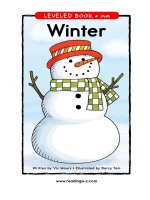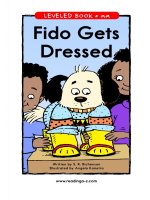raz ll10 sendmessages
Bạn đang xem bản rút gọn của tài liệu. Xem và tải ngay bản đầy đủ của tài liệu tại đây (1.66 MB, 18 trang )
Sending Messages
LEVELED BOOK • L
A Reading A–Z Level L Leveled Book
Word Count: 528
Written by Julie Harding
Illustrated by Maria Voris
Visit www.readinga-z.com
for thousands of books and materials.
www.readinga-z.com
Written by Julie Harding
Illustrated by Maria Voris
www.readinga-z.com
Table of Contents
Introduction................................... 4
Messages from Long Ago............... 5
Mail................................................ 7
Telegraph..................................... 10
Telephone..................................... 11
Walkie-talkies and Cell Phones..... 12
Email............................................ 14
Conclusion................................... 15
Index............................................ 16
Sending Messages • Level L
3
Table of Contents
Introduction................................... 4
Introduction
Messages from Long Ago............... 5
Have you ever written someone a
note? Have you ever sent an email?
If so, you were sending a message.
People have always found ways to
send messages to each other. The
way we send messages has changed
over time. Each change has allowed
people to send messages farther .
and faster.
Mail................................................ 7
Telegraph..................................... 10
Telephone..................................... 11
Walkie-talkies and Cell Phones..... 12
Email............................................ 14
Conclusion................................... 15
Index............................................ 16
Sending Messages • Level L
3
4
Messages from Long Ago
Beating on a drum was one of the
earliest ways to send a message.
Some of the earliest drums were
hollow logs. People beat on the .
logs with large sticks. This sent
signals a long distance. Sometimes
drumbeats could be heard several
miles away. Different drumbeats
meant different things. One might
send a warning of danger. Another
might announce that a meeting .
was going to take place.
Sending Messages • Level L
5
Messages from Long Ago
Beating on a drum was one of the
earliest ways to send a message.
Some of the earliest drums were
hollow logs. People beat on the .
logs with large sticks. This sent
signals a long distance. Sometimes
drumbeats could be heard several
miles away. Different drumbeats
meant different things. One might
send a warning of danger. Another
might announce that a meeting .
was going to take place.
Sending Messages • Level L
Smoke was also used to send
messages. A blanket was placed over
a smoking fire. When the blanket
was removed, a puff of smoke rose
into the air. Each pattern of puffs
meant something different.
5
6
Over time, people developed .
written language. This meant that
messages could be written and then
sent. Written messages became .
the first mail.
Sending Messages • Level L
7
Over time, people developed .
written language. This meant that
messages could be written and then
sent. Written messages became .
the first mail.
Sending Messages • Level L
7
The first mail carriers carried mail
by foot. These runners ran long
distances to carry mail. Sometimes
a group of runners carried a piece .
of mail. Each runner ran a part of
the total distance.
8
Later, horses were used to carry
mail. This way of carrying mail was
called the Pony Express. Trains then
replaced horses. Mail is still carried
today. Most mail is now carried on
trucks and planes.
Sending Messages • Level L
9
Telegraph
Over 150 years ago, a man found a
way to send signals over a wire. His
invention was called the telegraph.
His name was Samuel Morse. .
The signals he used were known as
Morse code. This code was a series
of dots and dashes. Each dot or
dash was heard as a signal. Different
patterns stood for different letters.
Look at the chart below. Can you
write your name in Morse code?
Later, horses were used to carry
mail. This way of carrying mail was
called the Pony Express. Trains then
replaced horses. Mail is still carried
today. Most mail is now carried on
trucks and planes.
Sending Messages • Level L
9
1 .----
2 ..---
3
-- 4
7 -- ...
8 --- ..
9 ---- .
C - .- .
D - ..
E
-
.....
6 - ....
0 ----- .
A .- .
B - ...
..
F ..- .
G -- .
H
J .---
K - .-
L .- ..
M -- .
N - ..
O --- .
P .-- .
Q -- .-
R .- .
S
T -.
U ..-
V
-
W .--
X - ..-
Y - .--
I
..
...
...
....
5
...
....
Z -- ..
International Morse Code
10
Telephone
A little more than 30 years after the
invention of the telegraph, someone
invented the telephone. This person
was named Alexander Graham Bell.
Using the telephone, people could
send voice messages over a wire.
Today, voice messages are sent
through the air on radio waves.
Sending Messages • Level L
11
Telephone
A little more than 30 years after the
invention of the telegraph, someone
invented the telephone. This person
was named Alexander Graham Bell.
Using the telephone, people could
send voice messages over a wire.
Today, voice messages are sent
through the air on radio waves.
Sending Messages • Level L
11
Walkie-talkies and Cell Phones
Once people found ways to send
signals through the air without wire,
new kinds of message senders were
invented. One kind was the walkietalkie. It got its name because you
did not have to stay in one place to
use it. You could “walk and talk.”
12
Today, many people carry small
wireless telephones called cell
phones. People can use cell phones
to talk from just about anywhere. Cell
phones are also used for texting—
sending short, typed messages.
Sending Messages • Level L
13
Computers have made it
possible to send and receive
messages over the Internet.
Internet messages are called
email, which is short for
electronic mail. Email is much,
much faster than regular mail.
An email can be sent to
someone on the other side .
of the world.
in an
instant.
Today, many people carry small
wireless telephones called cell
phones. People can use cell phones
to talk from just about anywhere. Cell
phones are also used for texting—
sending short, typed messages.
Sending Messages • Level L
13
14
Conclusion
One thing is certain. People will
always send messages to each other.
Message sending has changed a
great deal since early messages
were first sent. We will most likely
find even more ways to send
messages in the future.
Sending Messages • Level L
15
Index
Bell, Alexander Graham, 11
drums, 5
Internet, 14
mail carriers, 8, 9
Morse code, 10
Pony Express, 9
smoke signals, 6
texting, 13
Conclusion
One thing is certain. People will
always send messages to each other.
Message sending has changed a
great deal since early messages
were first sent. We will most likely
find even more ways to send
messages in the future.
Sending Messages • Level L
15
wireless phones, 13
16
Sending Messages
LEVELED BOOK • L
A Reading A–Z Level L Leveled Book
Word Count: 528
Written by Julie Harding
Illustrated by Maria Voris
Visit www.readinga-z.com
for thousands of books and materials.
www.readinga-z.com
Written by Julie Harding
Illustrated by Maria Voris
Sending Messages
Level L Leveled Book
© Learning A–Z
Written by Julie Harding
Illustrated by Maria Voris
All rights reserved.
www.readinga-z.com
www.readinga-z.com
Correlation
LEVEL L
Fountas & Pinnell
Reading Recovery
DRA
K
18
20









